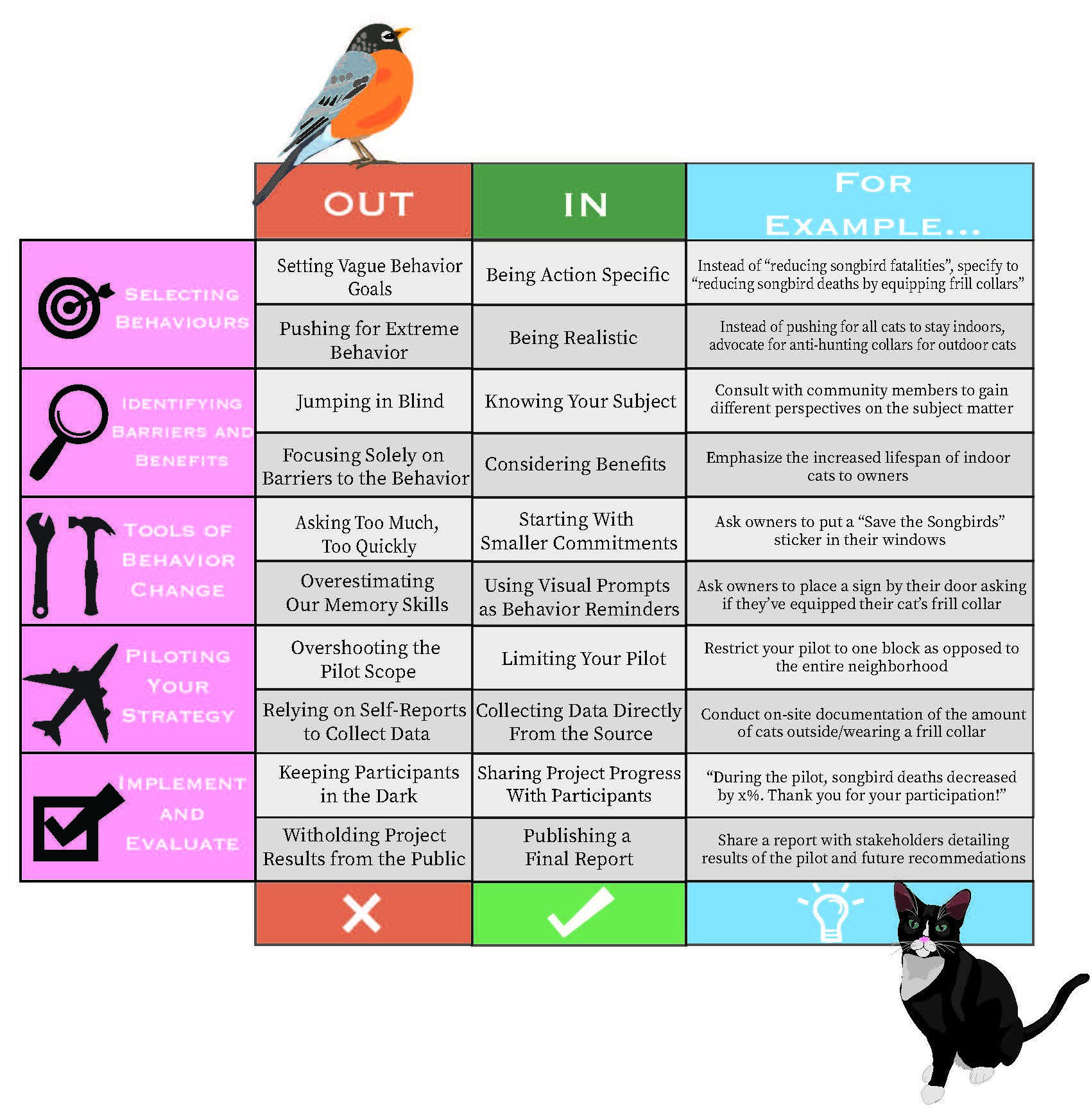By Abby Taylor
It’s been demonstrated time and time again that simply presenting audiences with the steps to make a difference rarely leads to any sort of behavior change. And, as is the case with many new year’s resolutions, individuals often find it difficult to actually follow through with these commitments long-term. Want to focus on a method of instigating long lasting and widespread change? Enter Dr. Doug Mackenzie-Mohr and Community Based Social Marketing (CBSM).
The goal of CBSM is to overcome our innate human tendency to resist individual change by delivering initiatives at a community level. This method focuses on dismantling barriers and enhancing the benefits associated with implementing sustainable habits. There are five main steps that make up CBSM:

In this article, we’ll take you through the framework step-by-step with some tips and tricks for success using a common (and controversial) invasive species problem: outdoor cats.
Outdoor cats can have devastating impacts on their surrounding environment, particularly in regard to small mammals and songbirds. One study estimated that each outdoor cat kills around 12- 16 songbirds per year. Assuming that ~50 million pet cats reside outdoors in the United States, this means that numbers upwards of 600-800 million songbirds are hunted every year by our fuzzy companions. Campaigns over the years have attempted to raise awareness for this issue, but to no avail. Cats remain one of the largest threats to birds in the country, and communities have been unable to enact meaningful change. Therefore, instead of raising further awareness about this issue, it may be more effective to approach the problem through the five steps presented by CBSM. Below, we have laid out some key tips for each step of CBSM using this fuzz-filled conundrum as an example.
Step 1: Selecting Behaviors
- Be Realistic: When selecting a behavior to change, targeting the most drastic change is not always the best option. For example, the most effective, but also the most difficult behavior change to implement would be to prevent pet cats from roaming outside in the first place. An alternative option is to have owners equip their cats with anti-hunting “frill” collars. The vibrant designs of these collars are particularly noticeable to birds, who have a fourth vision cone specifically designed to spot bright colors, and subsequently allows them to gain a headstart in escaping their hunters. When cats wear a frill collar, studies show a reduction in songbird mortality by up to 87%, meaning that this method of mitigation reduces the negative impacts of outdoor cats without withholding outdoor access.
- Be Specific: It is important to be incredibly specific about the action when choosing the behavior to aim toward. For example, rather than aiming for “reducing songbird mortality rates,” it is much more effective to specify this goal to ““increasing the utilization of anti-hunting collars on community outdoor cats”. ”.
Step 2: Identifying Barriers and Benefits
- Know Your Subject: The best way to understand the barriers and benefits associated with your sustainable behavior is to follow these four steps: 1)Review articles and reports 2)Observe the behavior firsthand 3)Form focus groups 4)Perform Random Surveys. This process ensures a solid foundation of understanding from which to build your pilot program off of.
- Delineate between internal and external barriers: Understanding the nature of the barriers that you seek to overcome is vital in creating a management strategy. In this example, one of the main internal barriers to address is the belief that denying cats outdoor access is inhumane. Indeed, the controversy that surrounds classifying outdoor cats as invasive stems from this very argument! Meanwhile, an external barrier emerges in the price that comes with purchasing a frill collar or building an enclosed “catio” to allow your pet supervised outdoor access.
- Don’t forget about the benefits: Barriers tend to be the main focus in the identification process, but understanding the scope of the benefits provided from this behavior change is also important. Emphasizing to cat owners that indoor cats live an average of 10 years longer than those allowed to roam outdoors, for example, is an excellent way to incentivize people to keep their cats inside.
Step 3: Tools of Behavior Change
- Start with small commitments: The key to maintaining lasting commitment from the individual is to start small. In the issue of outdoor cats, an effective first step could be to ask owners to put a small sticker in their windows that says “Protect the Songbirds!” This technique is shown to increase the odds that later on, participants will agree to a greater commitment (like putting an anti-hunting collar on their cat) and also follow through.
- Make Signs: Forgetfulness is a universal human fallacy, and one that can make it very difficult to stick with a behavior change. Therefore, visual prompts can aid in reminding us of our sustainable missions. It is important that these prompts are placed in close proximity to where the behavior should occur.For example, having owners place a sign on their front doors that reminds them to keep their cat’s collar on will elicit a more consistent behavior change than a billboard on the side of the highway of a similar nature.
Step 4: Piloting the Strategy
- Limit Your Pilot: The goal of a pilot program is to test out your CBSM strategy before committing to carrying out a strategy broadly. Therefore, take care to keep the pilot program manageable and affordable, especially if you plan to expand later into broad-scale rollout.
- Be Wary of Self-Reporting: When determining if a behavior has been changed as a result of your pilot program, try not to rely on self-reporting from the participants if possible, as their responses can be unreliable. Sole reliance on self-reporting tends to lead to inflated results that present a larger effect than what actually occurred. Instead, have researchers collect data directly from the source– in this case, that would be on-site documentation of the amount of cats outside/wearing a frill collar after the pilot’s initiative.
Step 5: Broad-Scale Implementation and Evaluation
- Provide Feedback, and Publish a Final Report: The only way for others to understand the impact of your initiative is to broadcast your results to the general public. Presenting this information through the lens of community involvement, in particular, will encourage other members within the community to follow suit. For example, encouraging those involved in the pilot program to display signs outside their home detailing the impact their involvement had on the local bird population would not only create positive press about the pilot program, but also influence others in the neighborhood to join the initiative . Once the results of your pilot have been presented and solidified with the public, you can move into the broad implementation of your CBSM strategy.

Good luck, and reach out to Green Fin Studio if you need help with public outreach campaigns or community-based social marketing!



